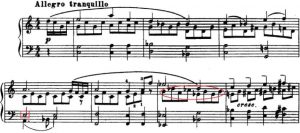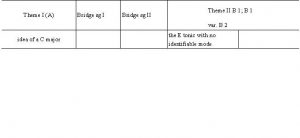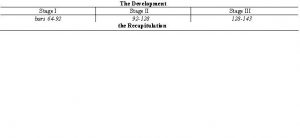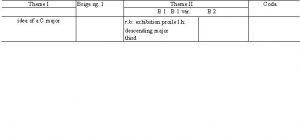STUDIUL ARTELOR ŞI CULTUROLOGIE: istorie, teorie, practică – Nr. 4 (27), 2015
STUDIUL ARTELOR ŞI CULTUROLOGIE: istorie, teorie, practică – Nr. 4 (27), 2015
REVISTASERGEI PROKOFIEV’S PIANO SONATA NO. 5 IN C MAJOR OP. 135: A STYLISTIC APPROACH
ARTICOLSERGEI PROKOFIEV’S PIANO SONATA NO. 5 IN C MAJOR OP. 135: A STYLISTIC APPROACH
O ABORDARE STILISTICĂ A SONATEI PENTRU PIAN NR. 5 OP. 135: ÎN DO MAJOR DE SERGHEI PROKOFIEV
EMANUELA PRIP,
asistent universitar, Academia de Muzică Gh. Dima Cluj-Napoca, filiala Piatra Neamţ
The Piano Sonata No. 5 in C major Op. 135 had two versions: the first one appeared in 1923 (The Piano Sonata no.5 op. 38) and the second one (no. 5 op. 135) was released in 1953, the year when the composer died, nevertheless he had started working at it a year before. In this masterpiece the musical language of the composer reaches maturity. The „steel fingers” technique is left behind in favour of a new approach that came hand in hand with the vocal compositions he had created abroad, while the piano sonority undergoes a metamorphosis from percussive elements towards more versatile ones.
Keywords: sonata, Prokofiev, stylistics, piano sonority, modal harmony
Sonata pentru pian nr. 5 în Do major a fost scrisă în două variante: prima apare în anul 1923 (Sonata nr. 5 op. 38), iar a doua variantă (nr. 5 op. 135) a fost lansată în anul morţii compozitorului – 1953, Prokofiev lucrând la ea din anul precedent. În această lucrare limbajul muzical al compozitorului ajunge la maturitate, tehnica „degetelor de oţel” este abandonată în favoarea unei altfel de abordări, venită poate în sinonimie cu lucrările sale vocale compuse în străinătate, iar sonoritatea pianistică se metamorfozează de la elemente percutante spre cele versatile.
Cuvinte-cheie: sonată, Prokofiev, stilistică, sonoritate pianistică, armonie modală
In institutions for musical arts, the mastery, the in-depth knowledge and the rendition of the 20th century music is a laborious process due to the novelties brought by composers in areas such as: the subtle harmonic sonority (Impressionism), the Viennese dodecaphony, the serial technique (Expressionism), the atonal systems or the bitonal superposition, the neoclassic influences, the personalized stylistic elements and many others. All these stylistic and musical findings can be found within the genre and the form of sonata. Although the tonal relationship disappears in the 20th century sonata, more often than not in the formal architecture, also the contrasting element between two or more thematic materials or musical ideas remains valid, with subsequent processing.
In Prokofiev’s creation, piano sonatas[1] are a summary of all his works. They have been written at all the stages in his compositions and depict a permanent developing process in the musical languages employed by the composer.
Prokofiev about Prokofiev
In his Authobiography, Prokofiev defines and divides his musical style into 5 main categories which best represent his creation. The first category is the (neo)classic – neoclassic elements can be found in sonatas and concerts, while in the Classic Symphony and in gavottes one can depict aspects imitating the 18th century classicism. The innovative category is to be found in the pursuit of an unique harmonic language which afterwards could express „strong feelings”. The third categories was that of toccatas, or in other words, the motoric one that can be identified in creations such as: Etudes op. 2, Toccata op. 11, Scherzo op. 12, the scherzo from the Piano Concert no.2, the ostinato effects from the din Scythian Suite or some parts of the Piano Concert no. 3. The lyric aspect (sometimes in a lyric meditative form), which had been for a long time faintly visible in the Prokofiev’s compositions, represents the forth stylistic trend. he last one hints at the grotesque, the stylistic category that his music has been ascribed to. Nevertheless, the composed refused this in favour of the expression „scherzando character” or three other words that gradually define the term, namely: joke, laughter, irony [1, p.256].
These five categories relate to all his creations and bring out the unique style developed by Prokofiev during his life. Of course that the Russian style is another feature that must be pointed out along with other inluences that came out from the contact with the artistic and music life outside his mother country (years of pilgrimage).1
Sonata no. 5 in C major op. 38/135
Prokoviev’s piano compositions have a unique stylistic element given the constant pursuit of the composer for an original and personal musical language. His piano creations merges virtuosity elements with lyrical ones, unusual harmonies and superpositions, with an divided and exceptional rhythm. Being a master of the piano Prokofiev makes full use of the instrument it in his 9 piano sonatas.
The Piano Sonata No. 5 in C major had two versions2: the first one appeared in 1923 (The Piano Sonata no.5 op. 38) while Prokofiev was still living in Ettal, and the second one (no. 5 op. 135, published in 1955, like op.39/125) was released in 1953, the year when the composer died. Nevertheless he had started working at it a year before.
Given the negative influence of modernism, the Sonata no. 5 in C major was harshly criticised by Nestiev, Prokofiev’s official soviet biographer; yet it occupies an important place in the world of piano compositions as both versions point out significant stages in the musical development of the composer. he time when he wrote op. 38 was the experimental stage for Prokoiev and he described it as being the peak of chromatic elements in his work [2, p.596].
The analyst Patricia Ashley refers to this Sonata in correlation with the Classic style, not the one from the Classic Symphony op. 25 (1916-1917), but a faint classic effect. As a result, the Allegro will receive nuances of tranquillo, the Andante nuances of Andantino, and ultimately the movement Un poco allegro [3, p.171].
| S. Prokofiev, Piano Sonata no. 5 op. 135, p. I, bar. 1-8 (the differences compared to op. 38) |
| 1 Once he had finished the Classic Symphony, Prokofiev, encouraged by Diaghilev manifests his desire to compose in a Russian style, being inspired by the revolutionary events from Russia. However, the project of a Russian Symphony has never seen daylight.
2 Sonata no.5 in C major is the only piano sonata Prokofiev had written while being outside Russia. Generally speaking, in the revison from op. 135 the highly complex parts are simplified harmonically and melodically. |
The first part of Sonata no. 5 in C major is based on the architectural design of sonatas, but dismissing the tonal relationship. The chromatics and the constant movement of the altered sounds lead towards the instability, or even dissolution of the tonal relationship between the two themes, both in the exposition and in the recapitulation.
| S. Prokofiev, Piano Sonata no. 5 op. 135, p. I, bar. 1-8 (the differences compared to op. 38) |

From the first theme, we can note two essential elements: the tone scale and the use of parallelism (octaves between the soprano and the bass, bar 3, 7 and 8) which hint at a modal course. The harmonization of the theme is mostly diatonic, while the functionality (the profile of tonality in C major from the beginning of the theme) fades out in favour of the modal harmony.
By contrast, the 2nd theme (B1) has a more sparse style given the uneven formation of the two musical phrases, but like in the case of the irst theme, it has an incomplete tone scale. In this case, tonality becomes even more ambiguous as the musical material revolves around a „tonic” E that has no mode attached (major, minor or modal) that could be categorised.
Prokoiev, Piano Sonata no. 5 op. 135
 The ample development is made out of 3 stages that abound with harmonic and counterpoint techniques. Each stage has a very well established diversifying role: the first stage is to be found in theme
The ample development is made out of 3 stages that abound with harmonic and counterpoint techniques. Each stage has a very well established diversifying role: the first stage is to be found in theme
I, the second one is developed in theme II, while the third one has a transitional role.
In the recapitulation, we can note some structural changes which relate to the bridge and to theme
II, but the thematic elements relatively maintain their musical design. Nonetheless, the harmonic fea-
ture of a (tonal) centre of gravity is driven towards a chromatic atonal perception; therefore, theme II
(B1 – 9 bars) keeps its expositional thematic profile at the right hand, while at the the left hand, we can
note a descending major third.
As previously mentioned, according to the composer, this sonata is one of the most chromatic creations of his. herefore, given this testimony and the merge of diferent typologies in musical expression – modality, diatonic scales and atonal structures, we chose not to make radical affirmations regarding the tonal course.
The Second part of Sonata no.5 in C major (Andantino) leaves the receiver with the sensation of a musical joke, a parody. The structural course can be divided into 3 main segments, namely A-B-A, based on a 16-bars theme where the musical design loses its linearity and a coda.
The most evident difference between op. 38 (1923) and op. 135 (1952-1953) are to be found in the third part of Sonata no.5 (Un poco allegretto). These do not refer to the formal structure, but rather to the musical language the composer used. herefore, ater revising the score, Prokoiev uses, as the case may be, another type of accompaniment. In the first version of the Sonata (third part, bar 6 to 9), the composer superposes two tonalities – the accompaniment was in C major while the theme had a B-flat minor profile. In the revised version of op. 135, the C major accent from the accompaniment will change into a precursory melodic figure.
In the Piano Sonata no. 5, the musical language of the composer exceeds the conservatory phase and reaches maturity. The „steel fingers” technique is left behind in favour of a new approach that came hand in hand with the vocal compositions he had created abroad. he piano sonority changes from a percussive to a more versatile one, but which was nonetheless enclosed in the social and cultural context of his mother country. Altering the sonority with modern elements is linked to the knowledge he had about other music cultures with faint impressionistic tendencies.
A stylistic element used by Prokofiev related to the origins of the tone scale as a result of the rhythmical accent put on the altered sounds from the chromatic scales or in situations similar to this sonata where the tone scale is a result of melody and harmony, with the due chromatic notes.
The usage of two „layers” – with and without alterations (polytonality?) – represents an superposition, both horizontal and vertical (harmonic) which gains the shape of an stylistic element in the creation of the composer. In this respect, we would like to draw the attention upon some terminological aspects used by Prokofiev which are hard to define, even impossible.
Given the stylistic and aesthetic lines that Prokofiev entrusted his creations with (Prokofiev about Prokofiev), in the Piano Sonata no. 5 in C major we can distinguish two of these features: the neoclassic feature that can be found at a formal level (as the composer appropriated this term in relation to his music) and the one that gives the impression of a joke, irony in the second move.
Prokofiev had an extremely important role in the national Russian school. Both criticized and praised, he was maybe the most important exponent of the composer-pianist typology while his sonatas involved a continuous process of development, censored at times, but also were a manifestation of the reality as the composer manages the perceive through a „(neo)classic” architecture with unique language elements.
Bibliographic references
- PROKOFIEV, S.Autobiografie, Însemnări. de N. Parocescu, Bucureşti: Editura Muzicală, 1960.
- NISSMAN, B, Prokofiev’s Two Versions of His Fifth Piano Sonata: Facsimile and Commentary. In: The Musical Times, 130, No. 1760 (Oct. 1989).
- ASHLEY, Prokofiev’s piano music: Line, Chord, Key. Rochester: Eastman School of Music of the University of Rochester, 1963.
Annex
SERGEI PROKOFIEV’S PIANO SONATA NO. 5 IN C MAJOR OP. 135 (the sonata form)

 [1] The first four sonatas had been written during his Conservatory years, namely Sonata no.1 op. 1 în F minor and Sonata no. 3 op. 28 in A minor, which are mono-partite. In his youth sonatas, Prokofiev mentions the collocation „from the Old Notebooks” (for Sonata no. 2 and no. 3) as they referred to the drafts he made while he was an adolescent and that the composer later used in the process of rewriting them. Sonata no. 5 op. 28/135 in C major is nonetheless unique in that the first version was written in 1923, and the second one was published in the year the composer died. The next three sonatas, no. 6, 7 and 8 are called „the Wars Sonatas” or „The Trilogy of War”, while the last piano sonata of Prokofiev is no. 9 op. 103, composed in 1947. There is also a Sonata no. 10 which has been left unfinished.
[1] The first four sonatas had been written during his Conservatory years, namely Sonata no.1 op. 1 în F minor and Sonata no. 3 op. 28 in A minor, which are mono-partite. In his youth sonatas, Prokofiev mentions the collocation „from the Old Notebooks” (for Sonata no. 2 and no. 3) as they referred to the drafts he made while he was an adolescent and that the composer later used in the process of rewriting them. Sonata no. 5 op. 28/135 in C major is nonetheless unique in that the first version was written in 1923, and the second one was published in the year the composer died. The next three sonatas, no. 6, 7 and 8 are called „the Wars Sonatas” or „The Trilogy of War”, while the last piano sonata of Prokofiev is no. 9 op. 103, composed in 1947. There is also a Sonata no. 10 which has been left unfinished.